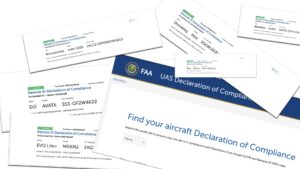Of all of the questions we’ve received since Monday when the FAA announced the new rules, timing of implementation and the different parts of it seem to be the most common. As such we’ve put together this timeline primer of the major parts of the new Final Rules.

There are two key dates attached to each new rule. Date of implementation and date of publication. Everything keys off of one of these dates.
And since date of implementation is tied to date of publication, we’ll start with publication. The FAA sent the Final Rules to Federal Registry on December 28th. The publication date is when the Federal Registry actual publishes the rules. That starts the clock on the effective date. The effective date is 60 days from publication.
Summary:
The Federal Registry published the rules on January 15, 2021. The compliance clock started on that date.
Effective Rule Date (not when you have to comply with Remote ID): March 16 of 2021.
Remote ID Compliance Date (when you have to fly a standard remote ID drone, have a module, or fly in a FRIA): September 16, 2023.
Drone Manufacturer Compliance Date (when manufacturers have to produce drones that are for sale in the United States that are in compliance with the rule): September 16, 2022
FRIA Rule Effective Date (when applications can start being submitted): September 16, 2022
Night Operations Rule Effective Date: March 16, 2021, once you complete recurrent training.
Operations Over People Rule Effective Date: March 16 for Category 1, Category 2 & 3 Means of Compliance (MOC) and Declarations of Compliance (DOC) applications accepted starting December 16, 2021, with Category 4 MOC and DOC applications accepted starting September 16, 2021.
Online Recurrent Training instead of UGR Test: March 1, 2021.
Remote ID:
There are two significant dates tied to the effective date. The first is the date manufacturers must begin producing RID compliant drones. That is 18 months after March 16, 2021. The second is the one everyone wants to get right. That is the date we as drone operators much comply with the RID rule. That is 30 months from March 16, 2021.
Those who will be producing RID modules have 60 days from publication (effective date) before they can start production. But they will also have to wait for the standards, so they’ll likely begin after their allowed production date.
FRIAs:
FAA Recognized Identification Area (FRIA) applications can start being submitted September 16, 2023. And one major change from the NPRM to the Final Rule is that FRIAs will only have to renew every 48 months instead of 24 months.
Night Operations w/o a Waiver.
107.29 Operational Daylight Waivers will no longer be required for 107 Pilots to fly at night. The FAA will have the study material for the recurrent training March 1, 2021. On march 16, 2021, Remote Pilots who have taken the new online recurrent training and be qualified to fly at night.
Here’s a bit of a hint, don’t try to log to take the recurrent training on March 16th, 2021. There are currently 201,937 Remote Pilots, but only 4,453 current 107.29 waivers. I’ll save you the math, there are 197,484 Remote Pilots without a 107.29 Waiver who could theoretically attempt to get the recurrent training on the March 16, 2021 in order to legally fly at night. The FAA system can’t handle that.
Which is one reason the FAA has given those who hold a 107.29 wavier an additional 30 days to take their training before all 107.29 waivers terminate on May 17, 2021. Still an overwhelming number. Plan accordingly.
On-line Recurrent Training:
This is something Remote Pilots have been wanting is an online UGR test. The FAA listened, and even went one step further. We now have recurrent training instead of a recurrent test. And it’s online. Did we mention it’s also free?
The timing parallels the Night Ops timing since Night Ops are tied to the recurrent training. The FAA will publish the study material 45 days after publication, and recurrent training can start on the effective date.
You do not need to take the recurrent training if you aren’t due. The 24 calendar month timing for your in-person UGR is still good. But if you want the night operations privileges, you have to take it. At that time your 24 month clock starts over.
Operations Over People (OOP) w/o a Waiver:
This is probably the most anticipated aspect of the new rules. We will be able to fly some of our drones over people w/o a waiver. But not all.
OOP can take place on the effective date. But that doesn’t mean we can fly OOP yet. The new rules are broken down into 4 categories. We won’t go into the categories here, this article won’t go into that categories, it’ll just talk about the timing.
Category 1 will go into effect on the effective date of the Final Rule. So theoretically you can start flying over people if you have a drone that meets the criteria for Category 1. And no drone currently in production meets that criteria. Drones have to weigh 250g over less, and have no exposed rotating parts that can lacerate skin. That means props. So it would require a cage, prop guards, or motor kill switch to stop the props. That doesn’t exist at the moment.
Categories 2 & 3 must have a declaration of compliance to qualify under their respective criteria. Those can start being submitted 9-12 months after effective date.
Category 4 requires an airworthiness certificate that shows it meets that OOP criteria. Those submittals may start taking place 6-12 months after effective date.
Hopefully this little primer will help with some of the confusion that surrounds the RID and OOP timeline. DSPA will be putting out more info as we digest more and more of the new rules. And if there are specific questions that come up, we’ll address those as well.
Have fun, fly safe, and please follow the rules.



Appreciate the timeline. There are some inconsistencies with what is stated in the 107.29 section, with what the FAA’s document states. Page 163 of the FAA’s document states, “The updated testing and recurrent training….. will be made available on the FAA website on [INSERT DATE 45 DAYS AFTER….]” This indicates that the actual testing and training will not be available until 45 days after publication of the rule in the register. The study material or AC 107-2 revision has not been given a date of release from what I could tell.
Thoughts?
Hi Spencer.
The study and training material will be available 45 days from publication, but since the rule won’t go into effect until 60 days after publication, that’s when 107 folks will be able to take the recurrent training.
But I’ll run this by our FAA contacts for confirmation.
Good question!
The FAA says that 107 Pilots can take the training before the date of implementation (60 days after publication), but it can’t be used for Currency requirements or night ops until the date of implementation.
So basically they’re putting it out early to get some people already to go at the date of implementation. So I strongly suggest folks do that. We all have a funny feeling http://www.faasafety.gov will likely experience overwhelming usage on the date of implementation.
Vic, I appreciate you looking into this. Their wording in the preamble regarding the 15-day difference is making more sense now. It will no doubt be a whirlwind of a couple weeks!
That 15 day difference was a bit confusing to me as well, but it hadn’t made it up the list of things to talk to the FAA about yet. Your OP did that. Glad it did.